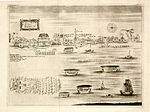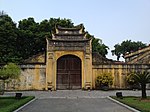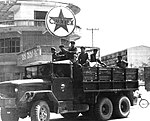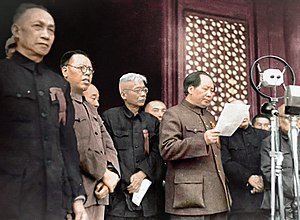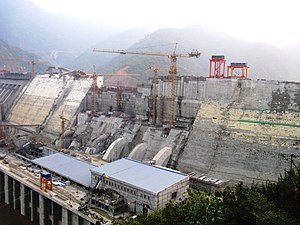History of Lavana
History
| Lavana Timeline of Significant Eras | ||||||||||||||||||||||||||||||
|---|---|---|---|---|---|---|---|---|---|---|---|---|---|---|---|---|---|---|---|---|---|---|---|---|---|---|---|---|---|---|
|
||||||||||||||||||||||||||||||
Pre-history
Rising power and Sayak Dynasty (3rd Century B.C.E-109 C.E.)
At the start of the 3rd century BCE, 3 major city-states became centers of powers in the region, Jaudau Sao, Dezenhua, and Bouna. These 3 cities maintained vast relationships with smaller city-states and principalities. The most prominent of these centers of powers was Jaudau Sao which controlled most trade coming in from the west of the region through the numerous tributaries of the Kung river. These cities avoided direct conflict do to the loose relationships that were maintained with principalities, which in some instances paid tribute to multiple entities. Old Ziba is expected to have been introduced in the 1st century CE, as a {[wp|Prestige_(sociolinguistics)|prestige language}} in noble courts.
Around the 1st century BCE, Jaudau Sao began employing the services of Ashinan mercenaries, to enforce greater control over their neighbors and rivals. Jaudau Sao came to rely on these Proto-Oroqic groups for warfare, and internal security. The term of Sao began to be used as a sign of ranking on the King of the 3 major city states. Charismatic and well connected Sao's in Jaudau Sao ensured the cities dominance over its rival peers during the 1st century BCE. Declining influence on the 1st century CE however would result in great instability for Jaudau Sao, which would result in Lao Va the leader of a band of Ashinan mercenaries to seize control of Jaudau Sao and establish the Sayak Dynasty on 33 CE.
The Sayak Dynasty coincided with an increase in violence, as the Sayak's sought to dominate by whichever way possible their rivals, and expand influence. Infighting among the Sao and his Ashinan counterparts would result in internal instability, finally culminating in general anarchy and conflict between 50 CE and 97 CE. During this period numerous warlords arose and carved petty kingdoms, with differing levels of centralization. This period would end when Pae Halin was crowned as Sao, establishing the Dhijivodhi empire with the Dhijivodhi dynasty at its head in 109 CE on the city of Jaudau Sao, which now attempted to enact greater territorial control over the other major centers of power.
Dhijivodhi empire (109-470)
Zibinego kingdom (470-763)
Burning of Jaudau Sao in 763
Aguda Empire (1476-1886)
Colonialism (1820-1940)
Growing Gaullican control over the Aguda Empire, coincided with dwindling commercial prospects in the major cities of the Kung river. Gaullican authorities favored coastal trading cities, and resource exploitation everywhere else. The 3 cities of Zebedize, Jaudau Sao, and Khaimuk suffered significant depopulation between 1820 and 1880, losing up to an estimated 400,000 people. The coastal cities of Dezebenhua and Ban Vuga swelled in population, although the vast majority of urban regions suffered widespread emigration. Ziba increasingly became sidelined by colonial authorities who encouraged Kachai populations to utilize Kachai as the language of administration alongside Gaullican.
Independence (1940-1959)
On October 3rd 1940, the Republic of Lavana came into existence following the first part of the Partition of Southeast Coius, which divided the territories of both former Gaullican and Estmerish territories in Southeast Coius. In a bid to reduce of influence of Socialist Dezevau, and establish a strong anti-Socialist state, the Republic of Lavana was made independent 3 months before the rest of the region was. Lavana was to negotiate independently with Hacyinia for territory exchanges, and migration agreements, along with the numerous Zejas that now existed in the territory. Hacyinia unable to obtain a favorable agreement that granted it control of the Oroqic lands now under Lavanan control, proceeded to invade Lavana on October 21st 1940 in the First Galshir war, where Lavana lost 1/3 of its country to Hacyinia. During this time, the Lavanan government struggled under the weight of migrations out of Dezevau, internal infighting, general inability of its government and armed forces to defend Lavana both from Hacyinia and an expected Dezevauni invasion. The invasion of Lavana would mark the highest extent of Hacyinia, and to this day is claimed by that country, it began the Hacyinian-Lavanan conflicts which continue to this day.
The end of the government was spelled in the increasing unpopularity of the Anti-Socialist coalition led by Nayaga Nurzhavong, with the centrist opposition, and Leftist coalitions strongly positioned in the upcoming elections. At the end of 1958, both the SDP, and NDP had lost support for Nurzhavong, and sought to form a majority government with the Centrist opposition with one of the two at the head, following an expected negative result for the FLC. Election night on March 1st, 1959 however came with extreme surprises as rural support for the LSWI ensured that the party would be the largest in Congress. The results sparked chaos in the ruling coalition and opposition at the face of a minority LSWI led government, although the FLC, SDP, and NDP agreed to a SDP led coalition government they could not obtain sufficient votes a 2/3 majority, to overturn the granting of government making powers to the LSWI, which was automatically done to the largest party. Nurzhavong along with Supreme Army General Oke Syrypanha, agreed that the LSWI could not be allowed to form a government, along with support from the President, and the SDP. Nurzhavong who was still Premier suspended the constitution and established martial law, in the hopes of arresting most of the LSWI top leadership inside Pers, as Army units rushed into the city and police blocked all entry and exit ways of the capital on March 13th, 1959. The plan however had been leaked and numerous LSWI leaders including Goube had escaped.
Civil War (1959-1961)
News from Pers were misinformed and numerous army units were not informed of what had occurred, and some forces thought a coup had taken place by Socialist forces. The news quickly mobilized the socialist forces into action, government forces had differing orders and were unable to prevent major socialist assaults, nor retake socialist controlled lands for several days. Socialist forces launched major offensives into Zadou, Dabadonga and the North. Government forces were able to stop socialist forces from Dabadonga and a deadly series of urban battles would follow for control of the city, Zadou was lightly defended and socialist forces were quick to take and secure the city, which was quickly proclaimed as the temporary capital of the Republic of Lavana as Goube announced that the congress in Pers was illegitimate. The socialist forces had secured Zadou and most of the Ziba speaking parts of the country, Dezevau were quick to provide aid to the socialist forces.
Government forces were caught off guard by the sudden start of the war, and numerous army units deserted rather than face the socialist forces. Dezevau which had been in discussion with Goube assured their support, Dezevau began the process of moving former Lavanan socialists back to Lavana. International reactions were split regarding the Republican attempt at undermining its own elections, with severe criticism from Socialist powers. The republicans were themselves split, as many believed it an attempt by the Anti-Socialist Solarian Right to take control of the entire system, under the guise of ensuring continued democracy. Numerous political movements closely aligned with the LSWI joined their government in Zadou, while others refused to take their seats in the Congress back in Pers. Socialists forces enjoyed widespread support, and quickly secured the northern areas of the country and began pushing south, up to 300,000 Dezevauni soldiers were said to have participated in the conflict as "volunteers".
Republican forces were not united in their conduct of the war as Nurzhavong led an unpopular coalition government. The SDP and NDP launched a leadership challenge on Nurzhavong resulting in the collapse of his leadership and the establishment of a SDP led government under Shager Mhuogezu on June 1959. Mhuogezu however did not have the general support of Supreme Army General Oke Syrypanha, who saw the politics of the Congress interfering with the conduct of the war. On September 27th, 1959. Socialists forces broke in the east of the country and quickly penetrated deep into Republican territory. Syrypanha launched a coup on October 19th, following threats of the NDP pulling out of the ruling coalition. The coup disillusioned numerous Dhavoni regiments who defected or deserted the armed forces. By the end of 1959, Republican forces fielded some 190,000 soldiers against 250,000 Socialist soldiers.
People's Republic (1961-1970)
Goube declared the People's Republic of Lavana, and declared it a one-party state, ending the multiparty coalition of leftist and Worker International parties in the country. Goube reformed numerous aspects of the Lavanan Congress, primarily the reduction in freedom of the body, and scope. Elections were no longer free and open, and instead citizens voted on single candidate races. The Congress of the LSWI was established as a parallel structure to the Lavanan Congress, which allowed inner party politics to remain inside the confines of the party. Goube quickly entered the International Socialist order, and foreign specialists arrived to the country.
1970's
1990's

Tensions between Lavana and Hacyinia remained high as Lavanan support for Ukilen and Majgar Workers International increased. On December 1991, 32 Ukilen soldiers trained inside Lavana were arrested trying to enter Hacyinia, leading to a diplomatic spat between both nations, with Hacyinia shelling Lavanan border crossing throughout the month. Dezevau had become increasingly worried about the situation in Hacyinia and worried that Lavana might launch a full scale invasion of the country, and stated that they would not support an invasion. Inthavongsa frustrated with Dezevauni reluctance and with limited support at home, refrained from invading Hacyinia but shelling between both sides continued until February its longest period since 1986. In the town of Shieli near the Lavanan border, Majgar insurgents were cornered and shelled throughout March and April, with large civilian populations unable to leave the town. Fearing heavy casualties in retaking the town, Hacyinian forces used Sarin gas to dislodge the defenders. The attack left 300 insurgents dead and 500 civilians killed after the Sarin was accidentally dropped on a civilian hospital. Inthavongsa quickly used the attack as a justification to mobilize the armed forces and to shore up support from Dezevau, which agreed to not oppose Lavanan intervention in Hacyinia.
Pers Acts 1994 reforms
2000's
2010's
The need of further electricity for Lavana, and further expanding it's energy diversity the Lavanan Congress approved in 2004 a wide variety of projects including the construction of along with numerous other projects including 4 nuclear reactors, and 2 wind farms but most prominently a dam in the Lav San river in the north of the country, which had been marked for possible hydroelectric potential in a study in 1994. The dam began construction in 2005, with help from Dezevau, the dam finished building in 2014, becoming the largest dam in Southeast Coius.
On November 11th, 2019 Premier Loe Vatthana died of a heart attack, and was succeeded by Vice-Premier Laina Keomany.

